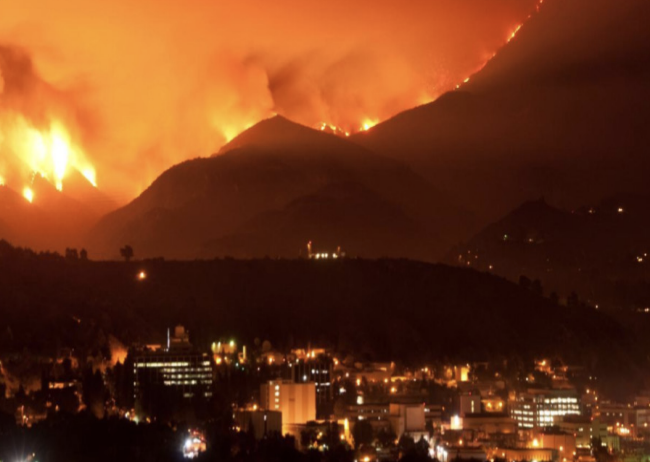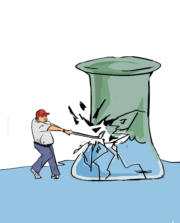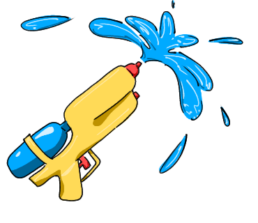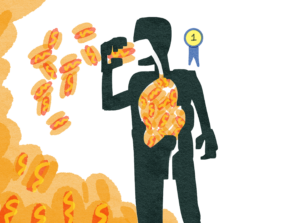
Courtesy of Flickr
Starting on Jan. 7, wildfires roared across the Los Angeles area, fueled by powerful winds and dry conditions. The fires destroyed at least 16,000 structures, 40,000 acres and lasted 24 days before full containment, killing at least 29 people in the process. Multiple fires raged, most notably in the Palisades, Eaton and Hurst. The Palisades and Eaton fires are some of the most destructive fires in California’s history.
Causes
The Santa Ana winds, which blow strong and dry winds through coastal Southern California and northern Baja California annually, have speeds that can go up to 100 miles per hour.
“When that wind happens, it’s very dry, so there’s no humidity or moisture in the air,” said Michael Lambrechts, Captain Paramedic at the Woodside Fire Department. “And then, if the fire is being pushed by [very strong] winds, think of it as a blowtorch. That is what Mother Nature has created essentially: a big, giant blow torch.”
Besides the annual Santa Ana windstorm, global warming also contributed to the severity of the fires.
“We’re just seeing the result of climate change,” said English teacher Genevieve Schwartz. “I don’t remember there being this level of wildfire experience. It’s really changed over the years, and it’s become more and more drastic, more frequent and more damaging than when I was a kid growing up in the 80s down there in LA.”
Effects
Junior Yasmine Santini from Palisades Charter High School first found out about the fires the morning they started.
“I woke up, and my dad rushed into my room and told me that there were fires in the Palisades and that everyone had to evacuate,” Santini said. “So I immediately texted all my friends that I knew that lived in the area, and then we started to prepare to leave my house… Honestly, it was really scary.”
Their family evacuated later that afternoon and stayed at a hotel for a little over two weeks.
“My house is fine, but there’s a lot of damage from the smoke,” Santini said. “We had to replace a lot of furniture and stuff outside. Our pool is completely contaminated. We have air purifiers in every room. It’s not the same, but I’m glad to be home.”
Palisades Charter High School was burnt by the fires, destroying parts of it and leaving the students unable to return to school. The school has, as a result, transitioned to online learning
“When I first saw it on the news, I was devastated,” Santini said. “I didn’t know what to do, because I’m extremely involved in my school, and it’s honestly my second home. I’m grateful that my school is still standing in some form.”
Aragon alumni and University of California Los Angeles freshman Lipika Goel first heard about the fires from a text from her dad.
“I looked up and in the distance, there was this giant plume of smoke,” Goel said. “On Tuesday evening, I was walking with my friends, and we went up to the top of the hill in the dorm area. And there were other people there too, who were just fascinated by the fact that you could see it.”
After the initial shock, Goel decided to pack an emergency evacuation bag before returning home a few days later. However, other students could not do the same.
“The biggest impact was on students who were out of state because, for them, it’s not as easy as taking an hour-and-a-half long flight,” Goel said. “I have a friend who’s from Virginia, and the fire was getting closer and things were just getting worse. We [told them], ‘if you want, you can just come [with us] if Virginia is too far. Don’t stay on campus anymore. It’s not safe.’ They were definitely put in a limbo situation. It’s a lot of time and effort and money to fly all the way to the East Coast just to come back in four days.”
Many students and staff at Aragon also had family members or friends who were affected by the fires.
“I have a niece down there [with her] husband and their three kids,” said substitute Assistant Principal Bettina Graf. “They live in an Altadena house that was declared a historical landmark, and the fire took their street out, except for their house, but it’s so smoke-damaged that the whole thing has to pretty much be ripped apart from the inside out. Their school is destroyed. They’re doing online [school] in a motel room in Burbank because everybody is displaced.”
Some in the Aragon community have personal connections to the area. Schwartz’s son spent time in the Palisades when he was younger.
“I remember his grandmother’s house was butted up against a park and we would go to the stream, and he would collect frogs,” Schwartz said. “We would go on hikes around there. We would take him to the little shops in the Palisades village parks. He was on the swings. He was playing on the fields. That whole part of his childhood is, in terms of the landscape, erased. And he didn’t even live there; I just can’t imagine the children who lived there, the people [who] grew up there, having that whole geography of memory just gone.”
Dean of students Donna Krause’s family resides in the Los Angeles area, and a few of them have found temporary quarters nearby.
“When these kinds of things happen, and you’ve got family and friends involved, it’s so hard not to be there,” Krause said. “It’s so hard not being able to get on a plane and fly down. You just feel so helpless you don’t know what to do about it. We were told not to get in a car and drive down … I wanted to go down and volunteer somewhere.”
Relief
Firefighters worldwide joined the initiative to help combat the wildfires and assist the survivors.
“It’s really amazing how firefighters from different places are coming to help fight the fires, firefighters from Oregon, some came up from Mexico,” freshman Emma Sakai said. “It’s really awesome how we’re all working together to try to help people.”
Justin Werle, Fire Captain at Woodside Fire Department, was deployed to Los Angeles to fight the fires but found that combating them was different than his previous firefighting experiences due to the extreme winds and lack of communication set up upon arrival. The firefighters had to work 70-plus hours with no sleep and spent the first few days protecting houses, before spending their time helping the community.
“When the fires finally settled down, we helped and assisted,” Werle said. “We helped them pick up their yards and fix things in and around their homes that had either blown over or singed or burnt … There were older people or individuals [who] were on ladders and who probably shouldn’t have been on ladders … So there’s a huge humanitarian effort as well. It’s not just firefighting, it’s doing the right thing and having that integrity to do the right thing when no one’s watching.”
Santini found a different way to help those in her community who are affected.
“I’m really just trying to channel all of my negative energy into positive energy,” Santini said. “That’s why my sister and a friend and I founded Pali Strong initiative to help rebuild Palisades Charter High School, because the only thing we can do as Pali students is to help rebuild and help assist the staff in whatever way we can.”
Pali Strong has raised around $23,000 to fund its initiative and has hosted a donation and skincare drive.
“Our donation drive was absolutely huge,” Santini said. “We received over 200 bags, and we distributed them to four different local organizations to assist us in relocating the resources to somewhere else that needs it more … We really want to help Palisades [Charter High School] grow until everything is back to normal.”
Pali Strong has plans to work with a local nonprofit called World Central Kitchen and mobilize a food drive as well. Others have joined volunteer efforts to help survivors.
“I have a daughter who lives in LA and fortunately, she was not near the fires, but she has been volunteering practically every day since the fires, handing out clothes,” Krause said. “Since all this happened, she immediately went to see where she could volunteer, and she’s been doing that ever since. She goes every day and goes to different places and volunteers.”
Those unable to drive down and volunteer can help by donating to organizations that can.
“I know that it’s difficult for us to get out of our own way and to look at our five bucks and say that’s the boba tea that I could have, or I need that five bucks for my immediate gratification,” said biology teacher Katherine Ward. “But if there is a time for us to think charitably, this is the time to do it. Your five bucks could go to the Red Cross, and that can make a big difference to someone who has lost their whole home.”
Relief can come in many forms, including lending an ear and raising awareness.
“[My niece’s] mom, my sister, passed away in 2018,” Graf said. “Her father passed away several years after that. So she really has no parents down there. So I talked to [my niece] quite a bit on the phone. [They created] a GoFundMe and [I was] just texting and calling everybody that I know to raise money for them. And that’s kind of the best support. Her kids text me now[because] they just want to talk to somebody.”
Prevention
The mid-Peninsula could suffer fires as well, and the Aragon community can learn valuable lessons from the recent Los Angeles conflagration.
“Have a plan with your family,” Lambrechts said. “What is our plan if we can’t make it back home, where are we going to meet as a family? We can go and meet at Grandma’s house or we [can] meet at this Starbucks over here, so we can get together as a family, and know [that] we’re all safe.”
Another way to prepare for an emergency is to create a to-go bag.
“Create a go bag that has enough materials to last for up to 72 hours for every person in the family,” said David Acuña, Public Information Officer and Battalion Chief of Cal Fire. “It allows for people to be self-sufficient, because in the first few hours [or] maybe f days, of a large wildfire like this, we’re not going to have a lot of resources to immediately address those who have had to evacuate. Having water, food and necessary medications is really important.”
When creating a to-go bag, people should also consider adding birth certificates, insurance and social security cards on a thumb drive. Alongside families preparing for emergencies, Aragon also has procedures for an oncoming fire.
“If [a fire] happened at the school, then there’s a fire alarm, and the normal fire drill protocols exist” said Interim Assistant Principal Clarisse Mesa. “If there’s a fire in the community, then there are community safety protocols about where [people should gather for] shelter and evacuation locations.”
San Mateo County and its firefighters are prepared in case of a wildfire.
“We all work together,” Lambrechts said. “We all train together. We have annual training that we do during the wildland season. So the alarm plan is very robust here in San Mateo County … and every agency will come together to support each other here in San Mateo.”
The city also places an emphasis on fire education, doing community outreach and working with different organizations to educate people on what they can do to prevent wildfires.
“The fire department spends a lot of time trying to educate property owners, whether it’s an individual home or a business, on how to prepare against wildfire, how to cut down brush, how to make sure there is no standing dead wood, [how to] cut down their grasses,” said San Mateo’s City Council Member Lisa Diaz Nash. “San Mateo in particular, we have an emergency plan ready for different scenarios, if there’s a wildfire from the West, if there’s flooding from the north, whatever it happens to be.”
Students can go to fire.ca.gov, readyforwildfire.org or download Nixle to stay up to date on community information or learn more about fire safety.



